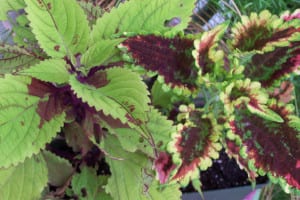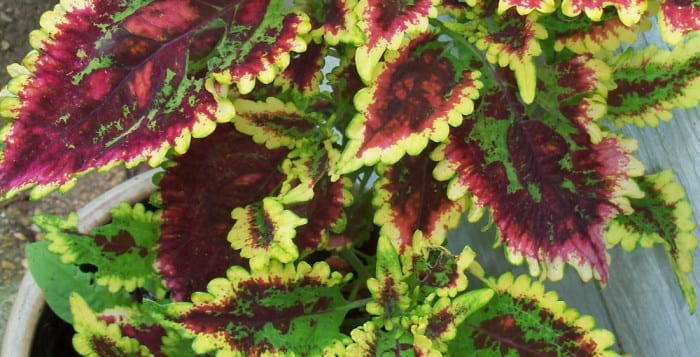By Ellen Barcel
There are a number of plants, grown as either annuals or herbaceous perennials, that are admired and grown for their leaves, not their flowers. Hostas are one of these as are aromatic mints, but so are coleus.
Coleus really brighten up a shady place and bring lots of color into the garden all summer long. You’ll find a number of scientific names for the plant, since botanists today frequently reclassify a plant after studying its genetic makeup.
Coleus, however, is in the Lamiaceae family — the mint family. While many plants in that family are aromatic, mints, thyme, sage, etc., coleus isn’t. But coleus does have the characteristic square stems of mints.
There are a number of ways you can grow your coleus: in a bed of plants outside, very nice scattered among hostas or other leafy plants; in a container outside or even as a houseplant.
Coleus are native to Southeast Asia and Malaysia. They are flowering plants. However, once the plant flowers and goes to seed, it has reached its life span and dies. So this is crucial: nip or pinch off the flowers in the bud if you want to keep your coleus growing and producing gorgeous, brightly pattered leaves.

Coleus can be propagated by seed —start indoors 8 to 10 weeks before the frost- free date — or by stem cuttings, rooted in water. If you choose to let the professionals start your coleus, like tomato plants, they can’t be put outdoors until it is warm enough, usually mid-May or, as my father always said, Memorial Day, just in case there’s an unusual dip in temperature. Because they are not cold-tolerant, they are considered annuals if grown outdoors on Long Island, but are evergreen perennials in warmer areas lasting for a number of years.
It shouldn’t surprise you, that being native to a warm climate, they are somewhat heat-tolerant, but that doesn’t mean drought-tolerant. Don’t let the soil get soggy, but do keep it evenly moist. If the soil dries out, the leaves will quickly wilt, but if you notice and water them fast enough, they may perk up.
Coleus leaves come in a wide variety of colors including green, yellow, white, burgundy, red, pink and black — actually a very dark burgundy. The green, of course, comes from chlorophyll, but the reds come from the chemical anthocyanin, an adaptation to attract pollinators to the plant.
Coleus can get quite large, but there are dwarf varieties. Check out the ones you’re interested in before purchasing them. They do best in a soil pH of 6.0 to 7.0, so you may need to add lime to your garden soil. Potting soil is closer to neutral, already.
As houseplants, keep in a warm place — 70 to 85 degrees is ideal, but not less than 50 degrees — with bright light.
As far as fertilizer goes, use compost, or if using chemical fertilizers, use once a month or as per package directions. If you’re growing your coleus in containers, you’ve probably used potting soil of one variety or another. Check it to see if it already contains fertilizer. If so, only start fertilizing when what’s in the soil is used up, which will be noted on the potting soil package.
As the cold weather approaches, you can bring containers inside to grow as houseplants or you can take cuttings from your favorite patterned/colored plants and root them in water over the winter.
Ellen Barcel is a freelance writer and master gardener. Send your gardening questions to [email protected]. To reach Cornell Cooperative Extension and its Master Gardener program, call 631-727-7850.





